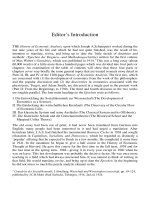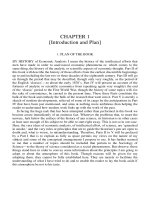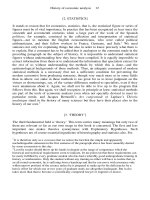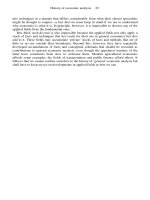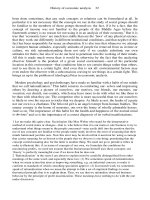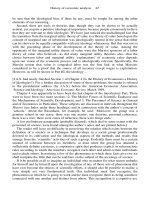History of Economic Analysis part 130 pot
Bạn đang xem bản rút gọn của tài liệu. Xem và tải ngay bản đầy đủ của tài liệu tại đây (35.91 KB, 10 trang )
Criticized, 578–84:
as restatement by Malthus, 578;
in first edition of Essay, 579;
in second edition of Essay, 579–80;
Godwin’s criticism, 579n;
paradox of its orthodoxy, 581–2;
in Marshall, Böhm-Bawerk, and Walras, 582, 890;
in Keynes’ early work, 582, 890n;
opponents of, 582–3;
Marx and, 583, 650, 651n;
in wage-fund theory of wages, 666;
in Wicksell, 258, 582, 863, 890n;
as postulate of classical period, 889;
not a postulate of neo-classical period, 889–90;
acceptance of by neo-classical theorists, 890;
‘Malthusianism in reverse,’ 890–91.
See also Demography;
Population;
Vital Statistics
Managed Currency, 321–2
Manchesterism, 398, 765, 888
Marginal Analysis, Turgot and, 261;
D.Bernouilli’s hypothesis, 302–5, 1054, 1089;
and law of diminishing returns, 587, 1054, 1089;
value and marginal firm, in Ricardo, 673–4;
Ricardo on marginal cost and productivity, 674n;
need for marginal principle, 677;
Ricardo’s marginal profits, 721;
Clark as discoverer of, 868–9, 918;
Wood’s discovery of, 869n;
neutrality of to social philosophy, 869–70
Marginal Efficiency of Capital, in aggregative analysis, 278n;
and money rate of interest, in Thornton, 721;
Fisher’s development of, 872, 1177–8;
and Marshall’s normal profit, 1049;
confusion with interest rate, Keynes on, 1119, 1178;
and Wicksell’s real rate of interest, 1119n;
and old marginal productivity of capital, 1144, 1178n;
as a determinant of income in Keynes, 1176;
meaning of, 1177–8.
See also Keynesian System
Marginal Productivity Principle, in Long- field, 464–5, 674n, 677;
in Thünen, 465–8, 674n;
diminishing returns and emergence of, 587;
Ricardo and, 674n;
Clark’s injection of value judgments, 870;
problem of equi-requisite factors, 914–15;
rediscovery of, 914–15;
marginal physical value productivity, 915;
social productivities, 915n, 996n, 998, 1029–30, 1042;
Austrian concept, 915;
in non-Crusoe economy, 916;
Subject index 1252
Longfield’s and Thünen’s vs. Jevons’ and Menger’s, 941–2;
Marshall’s, 941–2;
as partial derivative, 1036;
marginal efficiency and marginal productivity, 1144.
See also Diminishing Marginal Productivity, Law of
Marginal Propensity to Consume, see Keynesian System;
Propensity to Consume
Marginal Rate of Substitution, as substitute for marginal utility, 44;
Wood as precursor of, 941;
restrictions on in isoquant analysis, 1044n;
as rejection of Gossen’s law, 1066
Marginal Utility Principle, use of marginal rate of substitution, 44;
Galiani and, 301;
Fisher’s attempt to measure, 305, 872;
D.Bernouilli’s hypothesis, 302–5, 1054, 1089;
Cournot’s discovery, 463;
neglect of, in classical period, 463;
Senior credited with, 600;
Jevons’ priority, 826;
Menger’s discovery, 827;
Marshall as a builder of, 836;
Gossen’s First and Second Laws, 910–11, 1054, 1055, 1066n;
terms used by theorists to denote, 910n, 1055n;
extension by Menger to means of production, 912–13;
Dupuit and Gossen as forerunners, 915n;
and marginal productivity principle, 915;
Walras and, 918;
redundancy of, 1003;
Gossen’s linear functions, 1056n;
cardinal utility, 1060–62;
ordinal utility, 1062–6
Marshallian School, 833–4, 1099
Marxist System, surplus value, 192n, 390, 506, 649, 651, 652;
labor-quantity theory of value, 302, 309, 388, 390, 506, 554, 559–60, 596–8, 627n, 630–31,
649, 650–51, 661–2, 673n, 685, 883–5;
interest theory, 193, 647–51, 652–4, 661–2;
theory of money, 290, 699–701, 702;
wage theory, 390, 650–51, 664n, 685–6, 939n;
theory of classes, 439, 440, 551, 552–4;
difficulty of sub-dividing, 383–4;
as product of bourgeois mind, 387;
economic interpretation of history, 389, 438–42, 462n;
capital-labor relations, 389;
theory of technological unemployment, 390, 651n, 685, 686;
tableau économique, 391;
Hegelian philosophy and, 392, 438;
on bourgeois radicalism, 395;
evolutionism, 391, 438–42, 544, 651, 686, 749–50, 1131;
as unitary social science, 441;
theory of exploitation, 479, 596, 647–51, 896;
Dühring’s attack, 509n;
theory of distribution, 543n, 566, 569, 650, 664n, 933n, 939n;
Subject index 1253
sociology, 389, 551;
‘bourgeois’ economics, 455n, 559n;
on Proudhon, 457;
and entrepreneur, 462, 556n, 646, 896;
accumulation and capital theory, 556n, 583, 595n, 634, 635, 652, 661–2, 686, 749–50, 882, 887,
902–3, 927n, 1131;
stationary state, 562, 651, 965–6;
and Quesnay, 566n;
output as datum, 569;
theory of economic development, 573–4;
Malthusian principle and, 583, 650, 651n;
and Ricardo, 390, 596–8, 649, 654, 681, 682n, 683, 685;
on abstinence theory, 640, 660–62;
profits, 462, 556n, 646, 649, 682n, 896;
and Smith, 648–9;
absolute law and, 685n;
monopoly trend, 686;
breakdown of capitalism, 687, 748–9, 882, 1131;
on business cycle, 652, 740n, 742, 747–50, 1131–2;
methodology, 562, 651, 748, 965–6;
effect on Sombart, 818;
effect on Böhm-Bawerk, 846, 927n;
Bortkiewicz’s revision of price theory, 851n;
attempts to Keynesify, 885;
theory of socialism, 986;
decreasing costs, 1051;
effect on Tugan-Baranowsky, 1126n.
See also Marxism
Marxism, Gotha congress, 454n;
Ricardian socialists and, 479;
Revisionism, 532, 882–3;
Fullarton’s work on banking, 725n;
rise of Marxist parties, 762, 774;
on imperialism, 764, 882;
Engels and Dietzgen, 775;
influence on German economists, 843, 849;
Böhm-Bawerk on, 845
In neo-classical period, 877–85:
as sect and school, 878;
scientific work of, 878;
German Social Democratic party, 879;
Engels, Luxemburg, Kautsky, 880;
Neo-Marxists, 881–2;
Marxist revival, 883–5;
criticism of marginal utility, 887;
emphasis on objective facts, 887;
profits and interest, 896;
exchange economy and use economy, 912n;
retention of Marx’s theory of interest, 926.
See also Marxist System
Materialism, and idealism, 30n;
atomistic, 66;
Subject index 1254
philosophical, and deism, 123;
and environmentalism, 434;
evolutionary, 772
Materialistic Interpretation of History, 786;
Buckle’s theory as, 435;
Marx’s theory, see Marxist System;
Schmoller on, 811
Mathematics, importance of, 14n, 603, 955–6;
‘discovery’ of calculus, 18n, 956n;
Jevons and, 826
Cournot and the mathematical school, 954–63;
mathematical economics, defined, 955;
elementary nature of before 1914, 955;
contribution of Cournot, 958–63
Meaning of system of simultaneous equations, 970;
autonomy vs. independence of a function, 970n;
homogeneous functions of zero degree, 1005n;
continuous vs. smooth functions, 1027n;
linear homogeneous functions, 1033n.
See also Econometrics;
Euler’s Theorem;
Probability, Theory of;
Statistics
Mature Economy, 252
Maximizing Behavior, Theory of, 912n
Mercantilism, and Colbert, 147n;
avoidance of term, 155;
Smith on, 186–7, 335, 337n, 360–62;
Child’s Discourse of Trade, 195–7;
on population, 251;
and unemployment, 272;
contributions to Keynes, 283n;
and free coinage, 298;
quantity theory of money and, 314;
metallist theory of money and, 314
Literature, 335–76;
19th-century opinions of, 336;
export monopolism, 338–40;
exchange control, 340–45;
lack of theoretical analysis, 343–4;
‘primitives,’ 343–4;
balance of trade, 345–62;
from 1675–1775, 362–76;
and classical theory of international finance, 733;
crises, 738.
See also Neo-Mercantilism.
Metals, Monetary, 144–5, 311, 694, 716–17
Metasociology, 120–21, 124–5
Methodology, ‘Ideal Types,’ 80, 606, 818;
and division of problems, 219
In classical period, 536–41:
Ricard ian Vice, 473, 541, 618, 653n, 668, 1171;
Subject index 1255
validity of procedures, 536–7;
analogy with physical sciences, 537;
use of ‘law,’ 537;
induction vs. deduction, 537;
isolation and abstraction, 537–8;
introspection, 577;
common experience, 577
In neo classical period:
J.N.Keynes, 777, 824;
Simiand, 777, 820;
and philosophy, 779–80;
worker’s material and methodology, 785n;
historical school’s, 807, 808, 812
The Methodenstreit, 814–15:
in classical period, 538–40;
ebb of historism, 814;
facts in, 814;
elements of in England, 824;
methodological clashes in sciences, 815
Spiethoff’s, 816–17;
Weber on, 818–19;
in England, 823–4;
defense of, 886–9;
subjective vs. objective theory, 919n;
static analysis, see Static Analysis;
dynamic analysis, see Dynamic Analysis;
stationary state, see Stationary State;
partial analysis, see Partial Analysis;
in cycles, 1125, 1165–6;
macrodynamic studies, see Macroanalysis
Microanalysis, and macroanalysis and monetary analysis, 279;
Ricardo’s methods of analysis, 472;
Ricardian Vice, defined, 473
Minimum-of-Existence Wages, see Wages, Theories of
Model-Building, 561–2, 565–6, 632
Modern Period of Economic Analysis, 1914 to Present, World War I not causal factor, 1145;
wealth of statistics, 1146;
new developments of old theory, 1146;
development of dynamics, 1146;
few new scientific problems, 1146–7;
analytically novel problems, 1147
Monetary Analysis, defined, 277–8;
and macroanalysis, 278–80;
spending and saving, 280–82;
defeat of, 282, 287–8
Interlude of, 1600–1760, 283–5;
Becher and, 283–4, 326n;
Boisguillebert and, 284–7;
Quesnay and, 287–8;
in Malthus, 482, 483;
neutrality of money in classical interest theory, 720.
See also Real Analysis
Subject index 1256
Monetary Co-operation, International, Latin, Scandinavian, and German Unions, 1076;
Paris Conference of 1867, 1076;
conferences of 1878, 1881, 1892, 1076–7;
Wolf’s international gold reserve plan, 1077
Monetary Management, schemes for in post-Napoleonic England, 713–17;
Thornton, 713, 721–4;
tabular standard, 489, 526, 713, 714, 1078;
T.P.Thompson on, 713;
Scrope on, 713–14;
Bollman on, 714;
Birmingham Currency School, 714–15;
Mill on, 715;
and gold inflows of 1840’s, 716–17;
French bimetallism, 716–17;
banking and currency schools on, 727
In neo-classical period, 770–71:
awareness of need to control money market, 770;
schemes to divorce circulation from gold, 1077;
employment and, 1077;
bimetallism as scheme of, 1077;
government bonds as a stabilizer, 1078;
control of exchanges and bank credit, 1078;
Jevons’ plan, 1078;
Marshall’s plan, 1078–9;
Fisher’s ‘compensated dollar,’ 1079;
Walras’ plan, 1079
In modern period:
Keynes paper standard, 693.
See also Bimetallism;
Symmetallism
Monetary Theory, in Plato, 56;
in Roman law, 70n;
in latin scholasticism, 94–5, 99–101;
in More’s Utopia, 207;
in Turgot, 249;
Cantillon’s, 291, 706
In classical period:
Smith’s, 191, 193, 290, 312, 720, 731;
Senior’s contributions, 484;
Malthus’, 482;
Nazzani’s work, 512;
Ricardo’s, 473, 688n, 693, 699–701, 703–4, 708–12, 715n, 717n, 724, 737, 1079, 1112,
1118;
issues from Restriction Act to gold inflation of 1850’s, 688;
Mill as summarizer, 689;
problems of England during the period, 690–98;
Bullion Report of 1810, 692;
controversy over standard, 693–4;
Tooke on, 694, 708–10, 712–13;
Palmer’s rule, 697–8;
lack of interest in theoretical fundamentals, 698–9;
theoretical and practical metallists, 699–701, 702;
Subject index 1257
theory of value of money, 701–2;
and earlier English work, 706
Bullionists vs. anti-bullionists, 706–11:
Thornton’s analysis, 689, 706–7;
other bullionists, 707–10;
Mill on, 710–11, 1083n;
Resumption Act and, 711
In neo-classical period, 1080–86, 1117:
Davidson’s work, 862n;
no revolution in, 1080;
empirical work in, 1080;
failure to systematize, 1081;
Walras’, see Walrasian System;
Fisher’s, 314n, 721n, 872–3, 1075, 1079, 1082–3, 1101, 1102–3, 1115;
Marshall’s, 720n, 1075, 1078–9, 1083–4, 1087–8, 1099, 1108–9;
Wicksell’s, 863, 1085, 1088;
Austrians’, 1085–6;
neutral money, 1088–9;
supply-demand mechanism and, 1090;
in interest and cycle theory, 1117;
attempts to extend marginal utility theory to, 1089
Cartalist theory of, in Plato, 56;
defined, 63;
in Quesnay, 234;
theoretical and practical, defined, 288;
in 17th and 18th centuries, 293–9;
and devaluation, 298–9;
affinity to quantity theory, 313
Cash-balance approach:
Locke and, 316;
in Walras’ later work, see Walrasian System;
as application of supply-demand, 1090;
and equation of exchange, 1108, 1109;
Cambridge
equation, 1108–9
Income approach:
in Tooke, 709–10;
and equation of exchange, 1109;
advantages of, 1109–11
Metallist theory:
in Aristotle, 56, 62–4, 289, 290n;
theoretical and practical, defined, 288;
theoretical in 17th and 18th centuries, 289–93, 318;
Petty on, 290;
anti-metallist tradition, 293–9;
and devaluation, 298–9;
stimulus to value theory, 300;
implications of simple, 313;
and mercantilists, 314;
tendency to delineate credit, 318;
Law and, 321;
in classical economists, 699–701, 702;
Subject index 1258
paper money, 700;
bullionists as, 708;
in neo-classical economists, 1087;
Knapp on, 1091
Quantity theory:
in Tomás de Mercado, 95n, 101;
Bodin as ‘discoverer’ of, 311–12, 312–14, 912n;
implications of, 312–16;
quantity theorem, defined, 312–13, 703;
in mercantilists, 314, 357n;
Davanzate, 313–14;
equation of exchange, 314–15, 1099–1106;
Beccaria on, 315;
Law and, 321–2;
in Serra, 354;
analogy with wage-fund, 666n;
interactions of prices and quantity of money, 691n;
Marx on, 702;
Senior on, 702–3;
Ricardo on, 703–4, 724, 737;
Mill on, 704–5, 711;
bullionists on, 708;
Wick- sell on, 710n;
Thornton’s analysis of effects of credit on output, 723–4;
Böhm-Bawerk and, 928n;
as example of comparative statics, 965n;
and supply-demand mechanism, 1090;
Fisher’s theory, 1083, 1096, 1097–8, 1100–3;
definition of concepts P, M, V, and T, 1096–8;
Wicksell’s M, 1097;
and equation of exchange, see Equation of Exchange;
German and French economists on, 1103;
criticism of, 1103–4;
and purchasing-power parity theory, 1106;
elements of in Keynes, 1176n
State theory, 288n, 1090–91.
See also Credit;
Hoarding;
Liquidity Preference;
Monetary Management;
Money;
Money, Value of;
Money, Velocity of
Money, functions of, 62–3, 297, 1087–90;
role in real analysis, 277;
and credit, 320–21, 699, 1097;
legal treatment of, 719–20;
discussion of nature of in neo-classical period, 1086–7.
See also Credit
Money, Quantity Theorem of, see Monetary Theory
Money, Value of, analysis of in 17th and 18th centuries, 300;
Law on, 321–2;
Subject index 1259
theory of value and, 701–2;
in neo-classical period, 1089
Index-number approach to, 1091–5:
Edgeworth’s work, 1092;
Walsh’s work, 1092;
Mitchell’s work, 1092;
Fisher’s work, 1092;
role of economic theorists in, 1092–4
Equation of exchange and quantity approach, 1095–1107;
cash-balance and income approaches, 1108–10.
See also Monetary Theory
Money, Velocity of, Petty’s concept of, 213, 316–17;
Cantillon’s work, 223, 316–17, 319, 706;
introduction into equation of exchange, 315–17;
cash-balance approach, 316–17;
and credit, 318–21, 705, 1097;
in Mill, 705;
Thornton on, 706, 720;
in Say, 710;
income velocity and Pigou, 1098;
not habitually considered constant, 1098;
Kemmerer’s short-run variability in, 1087, 1098, 1100
Monopoly, Aristotle on, 60–61;
in early national states, 150–55;
reasons for, 151–4;
nature of, 154;
in Smith, 189, 264–5, 309;
analysis before 1750, 305–6;
export monopolism, in mercantilism, 338–40;
and the staple, 340n;
in classical economists, 545–6, 602;
Roscher on, 546;
and supply-demand mechanism, 601n;
Cournot’s theory of, 602n, 839, 959, 960, 972n, 973, 976–8;
theory of rent in classical economists, 672;
trend toward in Marx, 686;
in American radicalism, 761, 801;
in land, Oppenheimer on, 854n;
in neo-classical theorists, 892;
monopolistic pricing and entrepreneurial gains, 897–8;
misuse of concept, 927n;
surpluses to factors in, 937;
theory of, 975–8;
isolated, 976n;
Marshall’s analysis, 960, 977–8, 1049;
maximization of profits over time, 1143;
Mrs. Robinson’s concept of, 1151–2.
See also Competition, Imperfect;
Competition, Monopolistic;
Discrimination, Price;
Oligopoly
Monopoly, Bilateral, see Oligopoly
Subject index 1260
Monopsony, 61n
Moral Philosophy, 29, 118n, 130, 141–2
Multiplier, foreign trade, in mercantilists, 350;
static nature of Kahn-Keynes’s, 1174n
Nation, 550
National Economy, 163–4
National Income, see Income Concepts
Nationalism, absence in feudalism, 75–6;
as ally of liberalism, 399;
romanticism and, 418–24;
List and German, 504–5;
in Carey, 516–18
Natural Law, in Roman jurists, 70
Concept of, 107–15:
importance in social sciences, 107;
ethico-legal concept, 108–10;
analytic concept, 110–13;
natural law and sociological rationalism, 113–15
In 17th century, 115–22:
Protestant scholastics, 116–22;
mathematics and physics, 118–19;
economics and political sociology, 119–22;
contributions to economics, 122
From 18th century, 122–42:
sociology of religion, 123;
English empiricism, 123–4;
science of human nature, 124–6;
analytical aesthetics and ethics, 126–30;
self-interest, common good, and utilitarianism, 130–34, 428–31;
philosophy of history, 134–7;
Encyclopédistes, 137–8;
and Quesnay, 138, 228–9, 232;
semi-socialists, 139–41;
moral philosophy, 141–2;
and Smith, 184;
and principle of population, 257;
metallist theory of money in, 290;
and free trade, 371;
19th-century systems of, 430;
Hildebrand’s hostility toward, 507
Natural Liberty, 184–5, 403
Natural Philosophy, 29, 118n, 141
Natural Theolgy, 123
Navigation Act of 1660, 152n
Neo-Classical Period of Economic Analysis, more complex techniques, 754;
development of teaching, 754–5;
economic associations and journals, 756–7;
background of, 759–80;
general economics of the period, 825–85;
as ‘neo-classic,’ 919–20;
Subject index 1261



